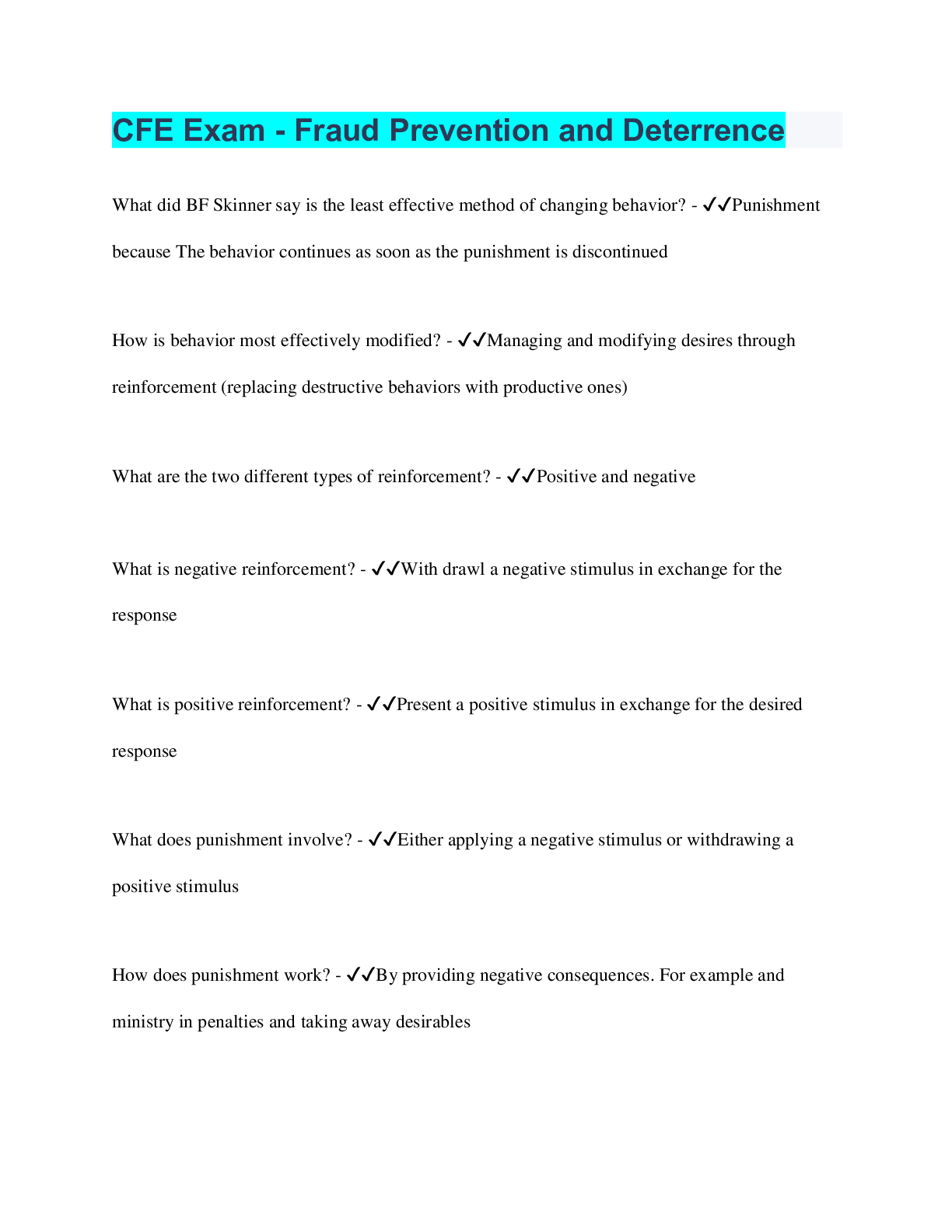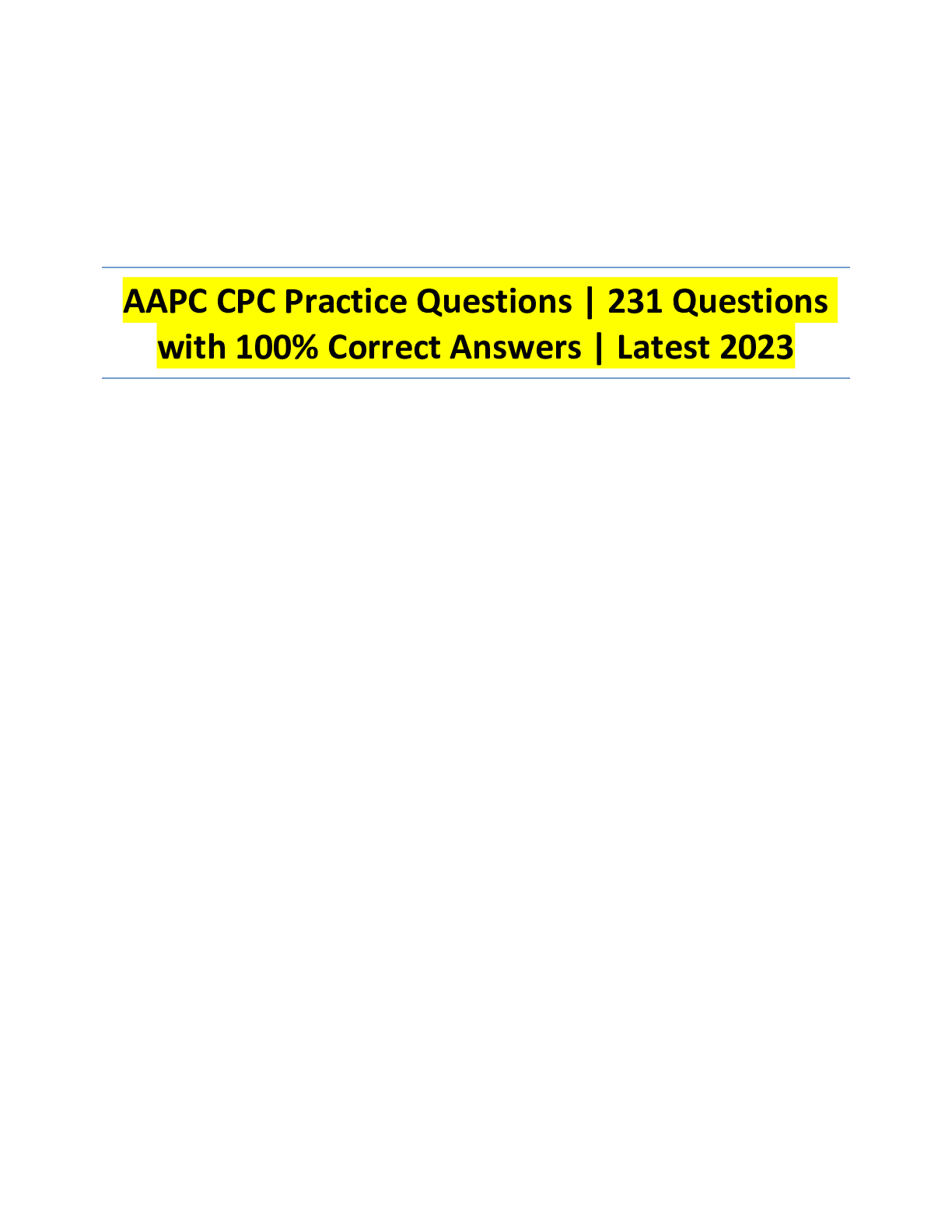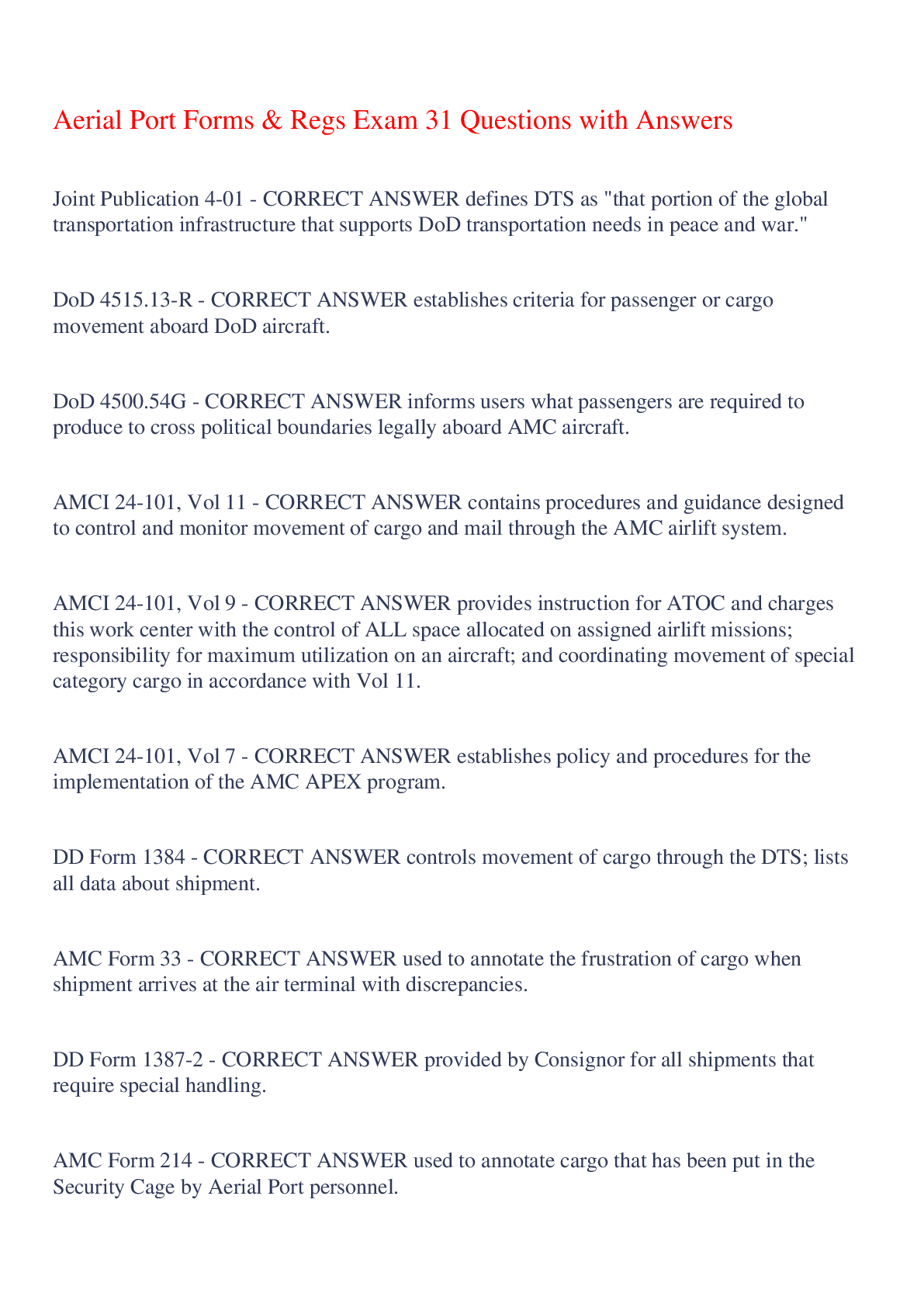NCLEX-RN Practice 31 Questions with Verified Answers,100% CORRECT
Document Content and Description Below
NCLEX-RN Practice 31 Questions with Verified Answers A client is referred to a surgeon by the general practitioner. After meeting the surgeon, the client decides to find a different surgeon to cont... inue treatment. The nurse supports the client's action, utilizing which ethical principle? 1. Beneficence 2. Veracity 3. Autonomy 4. Privacy - CORRECT ANSWER Answer: 3 Rationale: Autonomy is the right of individuals to take action for themselves. Beneficence is an ethical principle to do good and applies when the nurse has a city to help others by doing what is best for them. Veracity refers to truthfulness. Privacy is the nondisclosure of information by the health care team. Cognitive Level: Applying Client Need: Management of Care Integrated Process: Nursing Process: Implementation Content Area: Fundamentals Strategy: The core issue of the question is the ability to interpret which ethical principle is operating in a specific situation. Eliminate beneficence and veracity next because they focus on the obligation of the nurse rather than on a right of the client. A nurse forgets to administer a client's diuretic and the client experiences an episode of pulmonary edema. The charge nurse would consider the medication error to constitute negligence because the situation contains which element? 1. Purposeful failure to perform a health care procedure 2. Unintentional failure to perform a health care procedure 3. Act of substituting a different medication for the one ordered 4. Failure to follow a direct order by a physician - CORRECT ANSWER Answer: 2 Rationale: Negligence is the unintentional failure of an individual to perform or not perform an act that a reasonable person would or would not do in the same or similar circumstances. A purposeful failure to perform a procedure would be the opposite of negligence, which is unintentional. Substituting a different medication does not fit the description of the situation in the question. Failure to follow a direct order does not fit the description in the situation in the question. Cognitive Level: Applying Client Need: Management of Care Integrated Process: Nursing Process: Assessment Content Area: Fundamentals Strategy: Two options are opposites, which is a clue that one of them may be correct. Choose unintentional failure to carry out a procedure over purposeful failure because it matches the definition of negligence. A client asks why a diagnostic test has been ordered and the nurse replies, "I'm unsure but will find out for you." When the nurse later returns and provides an explanation, the nurse is acting under which principle? 1. Nonmaleficence 2. Veracity 3. Beneficence 4. Fidelity - CORRECT ANSWER Answer: 4 Rationale: Fidelity means being faithful to agreements and promises. This nurse is acting on the client's behalf to obtain needed information and report it back to the client. Nonmaleficence is the duty to do no harm. Veracity refers to telling the truth for example, not lying to a client about a serious prognosis. Beneficence means doing good, such as by implementing actions (e.g. keeping a salt shaker out of sight) that benefit a client (heart condition requiring sodium-restricted diet). Cognitive Level: Understanding Client Need: Management of Care Integrated Process: Nursing Process: Implementation Content Area: Fundamentals Strategy: Use the process of elimination. The correct answer is the one that matches the description in the stem; that is, the nurse made a promise to a client and kept it, which constitutes fidelity. An individual has a seizure while walking down the street. During the seizure, a nurse from a physician's office is noticed driving past without stopping to assist. The individual sues the nurse for negligence but fails to win a judgement for which reason? 1. The nurse had no duty to the individual. 2. The nurse did what most nurses would do in the same circumstance. 3. The nurse did not cause the client's injuries. 4. The nurse was off-duty at the time. - CORRECT ANSWER Answer: 1 Rationale: To be guilty of negligence, the nurse must have a relationship with the client that involves a duty to provide care. The relationship is usually a component of employment. The nurse did not necessarily do what others would do in this situation. Although the nurse did not cause the client's injuries, it does not prevent the nurse from assisting in this situation. Although the nurse was off-duty, the nurse could have assisted if motivated to do so. Cognitive Level: Understanding Client Need: Management of Care Integrated Process: Nursing Process: Implementation Content Area: Fundamentals Strategy: Use the process of elimination and nursing knowledge. The correct answer is the one that recognizes that the nurse was not in the role of employee at the time of the incident, removing the requirement of acting on the client's behalf. An adult female ambulatory care client receiving an oral anticoagulant is given aspirin for a headache while visiting a neighbor, who is a nurse. The client subsequently has a bleeding episode because of a drug interaction. The legal nurse consultant interprets that which necessary elements of malpractice are missing from this case? Select all that apply. 1. Breech of duty 2. Duty owed 3. Injury experienced 4. Causation between nurse's action and injury 5. Intent to cause harm or injury - CORRECT ANSWER Answer: 2, 5 Rationale: There was no nurse-client relationship because the nurse was acting as a neighbor and not in an employment capacity. Thus, there can be no duty owed. Intent is not a necessary element of malpractice, because malpractice can occur because of unintended actions as well. There was no breach of duty because there was no official nurse-client relationship, which accompanies an employment situation. There was injury experiences because of this event. The bleeding was caused by the interaction of the aspirin with the anticoagulant. Cognitive Level: Analyzing Client Need: Management of Care Integrated Process: Nursing Process: Evaluation Content Area: Fundamentals Strategy: Use the process of elimination. The wording of the question indicates more than one option is correct, and the focus is on necessary elements that must be present. First eliminate the intent to cause harm or injury, since this is not necessary to a charge of malpractice. Next note that there is no duty owed, and because of this, there can be no breach of duty, to choose these two options as the necessary missing elements. A client with cancer has decided to discontinue further treatment. Although the nurse would like the client to continue treatment, the nurse recognizes the client is competent and supports the client's decision using which ethical principle? 1. Justice 2. Fidelity 3. Autonomy 4. Confidentiality - CORRECT ANSWER Answer: 3 Rationale: Autonomy refers to the right make one's own decisions, which is the principle supported in this situation. Justice refers to fairness. Fidelity refers to trust and loyalty. Confidentiality refers to the right to privacy of personal health information. Cognitive Level: Understanding Client Need: Management of Care Integrated Process: Nursing Process: Implementation Content Area: Fundamentals Strategy: Use the process of elimination. The wording of the question indicates that only one option is correct and that you need to select the principle that is consistent with the circumstances in the question. The health care provider orders a medication in a dose that is considered toxic. The nurse administers the medication to the client, who later suffers a cardiac arrest and dies. What consequence can the nurse expect from this situation? Select all that apply. 1. The health care provider can be charged with negligence, being the person who ordered the dose. 2. As the employing agency, only the hospital can be charged with negligence. 3. The nurse and physician may be terminated from employment to prevent a charge of negligence to the hospital. 4. Negligence will not be charged, as this event could happen to any reasonable person. 5. The nurse can be charged with negligence for administering the toxic dose. - CORRECT ANSWER Answer: 1, 5 Rationale: Health care providers who prescribe incorrect dosages of medications are liable for their errors. The nurse is open to a charge of negligence for failing to verify and question the incorrect dose. The hospital can be sued as the responsible employing agency, but the health care provider and the nurse can also be charged with negligence. Terminating the health care provider and nurse from employment would not stop a lawsuit charging negligence for employee actions that have already taken place. Prescribing and administering incorrect doses are not considered events that routinely happen to "reasonable person." Cognitive Level: Applying Client Need: Management of Care Integrated Process: Nursing Process: Implementation Content Area: Fundamentals Strategy: The wording of the question indicates that more than one option is correct. Choose the response that holds both individuals accountable, since the nurse failed to question an incorrect dose and the health care provider ordered the incorrect dose. A nurse and teacher are discussing legal issues related to the practice of their professions. The teacher asks what the functions are of the Nurse Practice Act (NPA) in that state. The nurse would include which thoughts in a response? Select all that apply. 1. Accredit schools of nursing 2. Enforce ethical standards of behavior 3. Protect the public 4. Define the scope of nursing practice 5. Determine liability insurance rates - CORRECT ANSWER Answer: 3, 4 Rationale: A state's NPA serves to protect the public by setting minimum qualifications for nursing in relation to skills and competencies. One way it fulfills responsibility to protect the public is by defining the scope of nursing practice in that state. The state board of nursing approves schools to operate but does not enforce ethical standards. A state NPA has no role in setting liability insurance rates for nurses. Cognitive Level: Applying Client Need: Management of Care Integrated Process: Nursing Process: Implementation Content Area: Fundamentals Strategy: Use the process of elimination and basic nursing knowledge to answer the question. The wording of the question indicates that more than one option is correct and that the correct responses are worded as true statements. A staff nurse concerned about maintaining client confidentiality would take which action while carrying out assigned duties? 1. Read the records of clients not assigned to the nurse to become familiar with disease processes. 2. Share information about a client with nurses from the unit to which the client may eventually be transferred. 3. Allow the client's family to review the medical record to obtain answers to their questions. 4. Share information about the client with those involved in planning nursing care. - CORRECT ANSWER Answer: 4 Rationale: Client confidentiality is maintained when the nurse shares client information only with those currently involved in the plan of care. Staff should only access information about clients currently assigned to their care and should not access information about other clients on the unit not assigned to them. Client information should not be shared with nurses who are not currently working with the client. Family members would need approval from the client and the health care provider prior to reviewing a medical record. Cognitive Level: Applying Client Need: Management of Care Integrated Process: Communication and Documentation Content Area: Fundamentals Strategy: Select the response that protects the client's information, but allows communication necessary for the delivery of quality care. The nurse working in an acute care environment would utilize which strategies to reduce the risk of malpractice litigation? Select all that apply. 1. Discuss any errors with the client and family in detail. 2. Keep incident reports on file. 3. Maintain expertise in practice. 4. Offer opinions to clients when the situation warrants. 5. Report unsafe staffing levels to supervisor. - CORRECT ANSWER Answer: 3, 5 Rationale: Maintaining expertise in practice by keeping up to date in knowledge and skills aids in reducing the risk of malpractice claims by fostering continued competence in practice. Unsafe staffing levels can result in a higher incidence rate of errors, which could later lead to charges of malpractice. Thus, reporting such situations so they can be prevented should be beneficial. Discussing errors in detail with the client and family does not reduce the risk of malpractice claim. Incident reports should be kept on file but do not decrease the risk of malpractice litigation. The nurse should not offer opinions at any time as this not part of therapeutic communication. Cognitive Level: Applying Client Need: Management of Care Integrated Process: Nursing Process: Implementation Content Area: Fundamentals Strategy: Focus on malpractice as the concept being tested. Recall that maintaining expertise is the best way to reduce personal risk and that reporting unsafe staffing situations may help reduce personal risk and that reporting unsafe staffing situations may help reduce general agency risk by preventing omissions or errors due to insufficient numbers of caregivers to do the work required during the shift. The registered nurse (RN) must delegate care of an assigned client to an unlicensed assistive person (UAP) for the shift. Which client would be best to delegate to the UAP? 1. A client who would benefit from talking about the recent death of her husband. 2. A client with a urinary drainage catheter and nasogastric feedings who is on bedrest. 3. A client with an osmotic who has persistent problems with leakage. 4. A client who was transferred from the critical care unit 3 days ago is ambulatory - CORRECT ANSWER Answer: 4 Rationale: Factors to consider when delegating care include complexity of task, problem-solving innovation required, unpredictability, and level of client interaction. The ambulatory client is best to delegate because this client in likely to be stable with a low level of unpredictability. The client who recently lost her husband would benefit from professional communication with the RN and requires a high level of client interaction. The client receiving enteral feedings and is immobilized represents a more complex client, who is better assigned to a licensed nurse. The client with a leaking osmotic would benefit from problem-solving innovation and is best cared for by the RN. Cognitive Level: Analyzing Client Need: Management of Care Integrated Process: Nursing Process: Planning Content Area: Leadership and Management Strategy: The core issue of the question is basic concepts that are useful when considering delegation to a UAP. Use this knowledge and the process of elimination to make selection. Which task would not be appropriate for the registered nurse (RN) to delegate to a licensed practical nurse (LPN) or unlicensed assistive personnel (UAP)? 1. Instructing the LPN to reinforce teaching of the RN's assigned clients prior to discharge 2. Assigning UAPs to complete vital signs and document and report changes to the RN 3. Asking the UAP to assess and evaluate the client response to IV pain medication 4. Instructing the LPN to remove a dressing from a postoperative client's abdominal would - CORRECT ANSWER Answer: Rationale: Cognitive Level: Client Need: Integrated Process: Content Area: Strategy: The charge nurse on the night shift reports that the narcotic count is incorrect. The nurse has spoken to the responsible staff nurse and believes that substance abuse by the nurse is the cause. If substance abuse proves to be the cause of the incorrect count, what is the most appropriate next step? 1. Recount the narcotics with the staff nurse and take disciplinary action 2. Ask the staff nurse to leave the unit and report the incident to the American Nurses Association 3. Complete an incident report and report findings to the pharmacy and nursing administration 4. Submit the findings to the Council on Nursing Practice - CORRECT ANSWER Answer: Rationale: Cognitive Level: Client Need: Integrated Process: Content Area: Strategy: A quarterly audit is now due to evaluate implementation of an electronic medical record system on the nursing unit. As the unit representative who supervised the adaptation of this documentation system, how can the nurse best determine if nursing staff have accepted this change? 1. Nursing staff uses the electronic medical record daily in routine documentation 2. Nursing staff verbalizes the need for the electronic record but still hand-write nursing notes into the clients' charts 3. Nursing staff uses the electronic record sporadically to monitor clients' progress 4. Nursing staff likes the electronic record because they believe it saves them time - CORRECT ANSWER Answer: Rationale: Cognitive Level: Client Need: Integrated Process: Content Area: Strategy: The nurse on the hospital quality improvement team has been asked to evaluate nursing care on the nurse's assigned unit. After deciding to ask the nursing staff for assistance in this effort, what would be most appropriate for the nurse to initially ask the staff to do? 1. Track the number of supplies used by clients on the unit 2. Document the time spent on direct client care 3. Administer a client and family satisfaction survey 4. Assess clients and report acuity daily - CORRECT ANSWER Answer: Rationale: Cognitive Level: Client Need: Integrated Process: Content Area: Strategy: An RN is about to make first rounds after receiving an inter shift report at 3pm. In what order should the RN see the following clients? Place the options in order. All options must be used. 1. A 54-year-old client 4 hours post-cardiac catheterization who has mild discomfort at the access site 2. A client newly diagnosed with diabetes mellitus who needs reinforcement of sick day management guidelines 3. A client who arrived 30 minutes ago from the postanesthesia care unit 4. A client who is ready for discharge but will not have transportation home available until 5pm 5. A client with pneumonia who has received two doses of IV antibiotics and has an oxygen saturation of 93% - CORRECT ANSWER Answer: Rationale: Cognitive Level: Client Need: Integrated Process: Content Area: Strategy: A client is experiencing respiratory distress. Respirations are 32 breaths/min and shallow. The client is positioned in an orthopneic position, with a heart rate of 118/min and a blood pressure of 90/40 mmHg. The client is pale and confused. Which task should the nurse delegate to the charge nurse? 1. Head-to-toe assessment 2. Placement of a second IV site 3. Application of oxygen 4. Overhead page the respiratory therapist (RT) - CORRECT ANSWER Answer: Rationale: Cognitive Level: Client Need: Integrated Process: Content Area: Strategy: A nurse is assisting a client in room 1 with lunch. The charge nurse calls the nurse and states the client in room 3 is reporting pain and requests pain medication. What is the nurse's best and first action? 1. Finish feeding the client in room 1, then medicate the client in room 3 for pain. 2. Stop feeding the client in room 1, and medicate the client in room 3 for pain. 3. Finish feeding the client in room 1, and ask the charge nurse to medicate the client in room 3. 4. Ask the charge nurse to feed the client in room 1 while the nurse medicates the client in room 3 for pain. - CORRECT ANSWER Answer: Rationale: Cognitive Level: Client Need: Integrated Process: Content Area: Strategy: After receiving the inter shift report, the registered nurse (RN) has many tasks to complete during the next 12 hours. Which tasks would the nurse delegate to an unlicensed person (UAP)? Select all that apply. 1. Flushing a nasogastric tube on a client who has had a colectomy 2. Irrigating a clogged urinary catheter on an older adult client 3. Rechecking vital signs on a 30-year-old client with a BP of 100/60 4. Changing a dressing on a client with an infected diabetic foot ulcer 5. Measuring and recording hourly ruin output for a client who underwent nephrectomy - CORRECT ANSWER Answer: Rationale: Cognitive Level: Client Need: Integrated Process: Content Area: Strategy: The registered nurse (RN) is assigned to five clients for the shift. Which tasks are best delegated to the licensed practical/vocational nurse (LPN/LVN)? Select all that apply. 1. Repositioning a nasogastric tube on a client who has had a small bowel resection 2. Irrigating a urinary catheter on a client admitted from a skilled nursing facility 3. Rechecking vital signs on a 40-year-old asymptomatic client with a BP of 100/64 4. Changing a dressing on a client with a diabetic foot ulcer in the metatarsal area 5. Administering red blood cells to a client with a hemoglobin of 10.2 grams/dL - CORRECT ANSWER Answer: Rationale: Cognitive Level: Client Need: Integrated Process: Content Area: Strategy: The delivery of care system on a medical floor is team nursing. On wing A, there is a registered nurse (RN), licensed practical/vocational nurse (LPN/LVN), and an unlicensed assistant person (UAP) to care for eight clients. Which tasks would be best delegated to the LPN? 1. Vital signs and assessment of a newly postoperative client 2. Wound care and oral medication for all clients 3. Vital signs and bed baths on all eight clients 4. Physical assessments on two young, stable clients - CORRECT ANSWER Answer: Rationale: Cognitive Level: Client Need: Integrated Process: Content Area: Strategy: A nurse is delegating care of clients to the certified nursing assistant (CNA) and licensed practical nurse (LPN). Which tasks should the nurse give the CNA and LPN? 1. CNA: Measure vital signs; LPN: Give oral medications on assigned clients 2. CNA: Change a non-infected dressing; LPN: Administer IV piggyback medications 3. CNA: Ambulate a client who had a CVA; LPN: Assess two clients 4. CNA: Measure vital sign; LPN: Complete a head-to-toe assessment on a newly admitted client - CORRECT ANSWER Answer: Rationale: Cognitive Level: Client Need: Integrated Process: Content Area: Strategy: A nurse is preparing for the shift, and makes a list of delegated tasks for the unlicensed assistive person (UAP). Which task should the nurse delegate to the UAP? 1. Feeding a client who was admitted with dysphasia from cerebrovascular accident 2. Monitoring drainage from a chest tube on a client with a hemothorax 3. Rechecking vital signs on a client whose blood pressure is 190/102 4. Repositioning a client with severe weakness caused by multiple sclerosis - CORRECT ANSWER Answer: Rationale: Cognitive Level: Client Need: Integrated Process: Content Area: Strategy: A registered nurse (RN) who is the charge nurse for the shift is making assignments for the day. Which client should be assigned to the licensed practical nurse (LPN)? 1. A client with sickle-cell anemia requiring pain medications every three hours 2. A three-day postoperative client who will be discharged tomorrow morning 3. A 76-year-old client who will be discharged tomorrow morning 4. A client who received chemotherapy for leukemia and has a hemoglobin of 6.4 grams/dL - CORRECT ANSWER Answer: Rationale: Cognitive Level: Client Need: Integrated Process: Content Area: Strategy: The staff nurse who is in charge of the medical-surgical unit for the shift is receiving four admissions. The emergency department is sending a client with hypertension and an exacerbation of heart failure, and a client who has pneumonia and a history of diabetes mellitus. The post-anesthesia care unit (PACU) is transferring a client who had a total abdominal hysterectomy and a client who underwent hip replacement. If the staff consists of two RNs (one on orientation) and two LPNs, what assignment would be appropriate? 1. The RN on orientation will be assigned the postoperative client who underwent hip replacement 2. The experienced RN will be assigned the postoperative client who underwent hip replacement 3. An LPN will be assigned the client with pneumonia and history of diabetes 4. An LPN will be assigned the client with the abdominal hysterectomy - CORRECT ANSWER Answer: Rationale: Cognitive Level: Client Need: Integrated Process: Content Area: Strategy: An obstetric nurse is floated to a medical unit to care for a group of acutely ill clients. The charge nurse should assign which group of clients to the float nurse? 1. A client with a three-day-old total knee replacement, a client who is postoperative for colectomy, and a client who is postoperative for hysterectomy 2. An older adult client with dehydration, a client with atrial fibrillation, and a client just admitted with hip fracture 3. A client with an old cerebrovascular accident, a client with a three-day-old hip replacement, and a client with diabetic ketoacidosis 4. An older adult client with pneumonia, a client with an exacerbation of asthma, and a client who has below knee amputation - CORRECT ANSWER Answer: Rationale: Cognitive Level: Client Need: Integrated Process: Content Area: Strategy: A nurse plans to delegate some responsibilities of client care to a licensed practical nurse (LPN). Which task should the nurse delegate to the LPN? 1. Assessment of a newly admitted client 2. Admission of a postoperative client 3. Dressing changes for a client with wounds 4. Assist a client with ambulation and AM care - CORRECT ANSWER Answer: Rationale: Cognitive Level: Client Need: Integrated Process: Content Area: Strategy: A nurse has delegated a venipuncture to an unlicensed assistant (UA) who has been off orientation for five days. The UA reports, " This client has a large, raised red area where the need was inserted." The nurse's subsequent assessment reveals a hematoma in the venipuncture area. What elements of delegation have been breached? Select all that apply. 1. Task 2. Circumstance 3. Communication 4. Supervision 5. Skill - CORRECT ANSWER Answer: Rationale: Cognitive Level: Client Need: Integrated Process: Content Area: Strategy: Upon calling the health care provider regarding a client with "heartburn," diaphoresis, and irregular pulse, the nurse receives stat orders for the following: electrocardiogram, cardiac panel, morphine 2 mg IV push, nitroglycerin 0.4 mg sublingual, and aspirin 325 mg p.o. chew and swallow. Which tasks should the nurse delegate? Select all that apply. 1. Administration of medications 2. Reassessment of the client's condition 3. Venipuncture for the cardiac panel 4. Electrocardiogram 5. Oxygen saturation - CORRECT ANSWER Answer: Rationale: Cognitive Level: Client Need: Integrated Process: Content Area: Strategy: A registered nurse (RN) working on the medical unit arrives at work 15 minutes late. The nurse is assigned five clients, and an admission is on the way. Place in order of priority how the nurse should complete the following activities at the beginning of the work shift. Place the options in order. All options must be used. 1. Listen to report 2. Check the medication administration record (MAR) 3. Check on the status of all clients 4. Review morning lab results, including glucose monitoring - CORRECT ANSWER Answer: Rationale: Cognitive Level: Client Need: Integrated Process: Content Area: Strategy: A nurse is preparing for a busy day on a medical nursing unit. Prioritize the tasks and place the options in order. All options must be used. 1. Irrigate a nasogastric tube on a client who had a colectomy the previous day. 2. Flush a poorly draining urinary catheter on an older adult client. 3. Check vital signs on a 30-year-old client with a BP of 114/68 and a heart rate of 94. 4. Change a dressing on a client with an infected diabetic foot ulcer. 5. Begin a unit of packed red blood cells for a client with a hematocrit of 23.2%. - CORRECT ANSWER Answer: Rationale: Cognitive Level: Client Need: Integrated Process: Content Area: Strategy: [Show More]
Last updated: 7 months ago
Preview 1 out of 19 pages
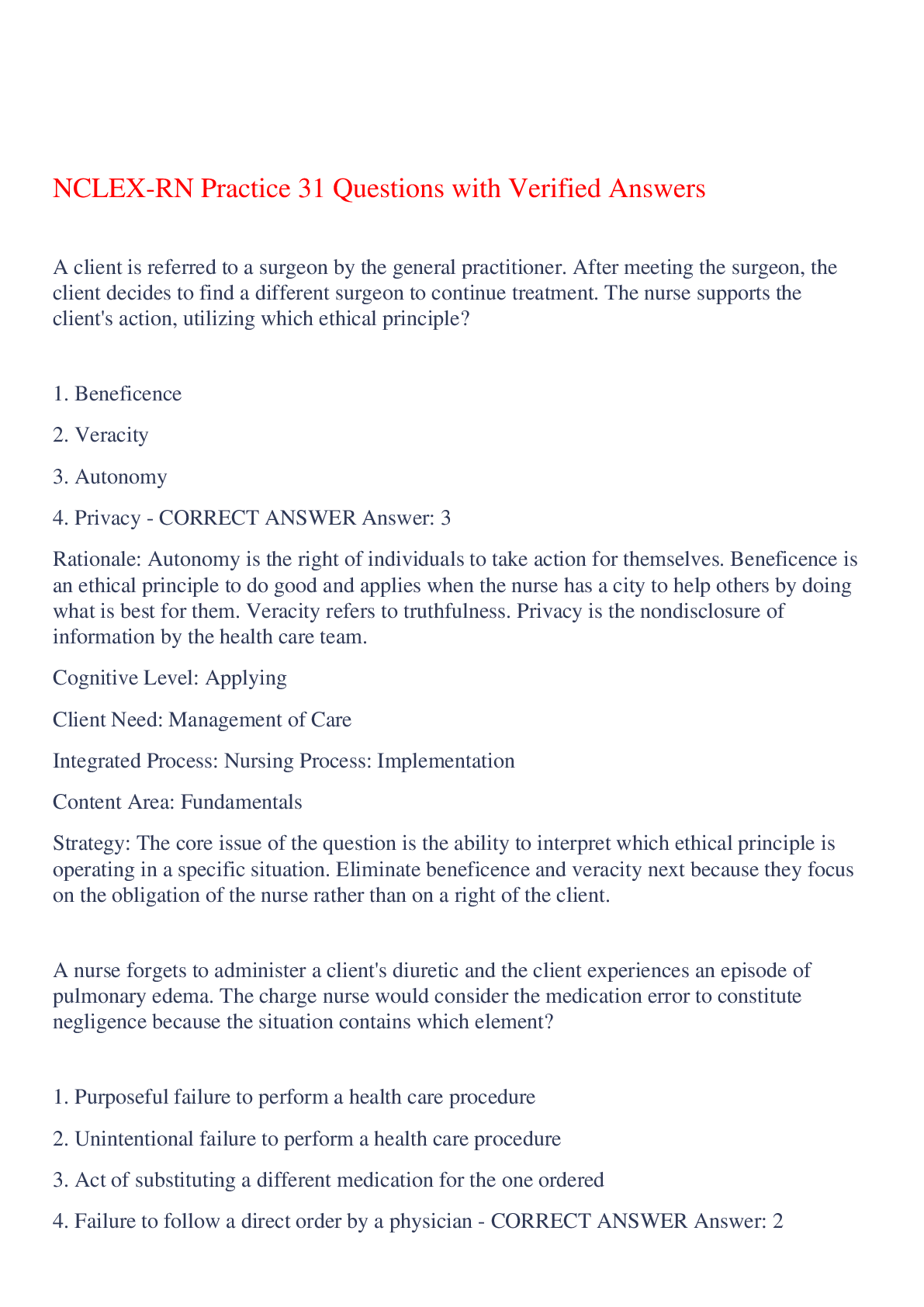
Buy this document to get the full access instantly
Instant Download Access after purchase
Add to cartInstant download
We Accept:

Reviews( 0 )
$8.50
Document information
Connected school, study & course
About the document
Uploaded On
Nov 13, 2023
Number of pages
19
Written in
Additional information
This document has been written for:
Uploaded
Nov 13, 2023
Downloads
0
Views
39














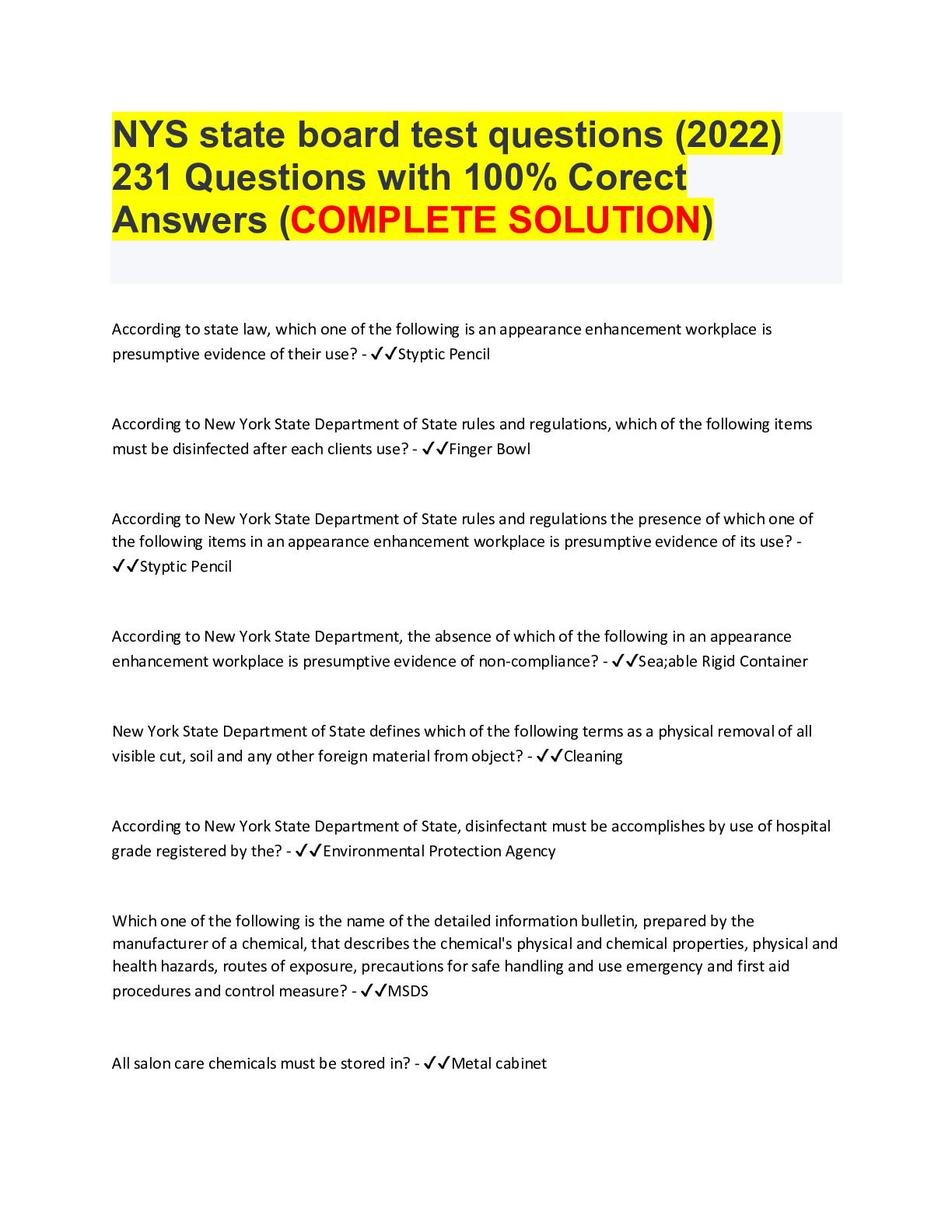
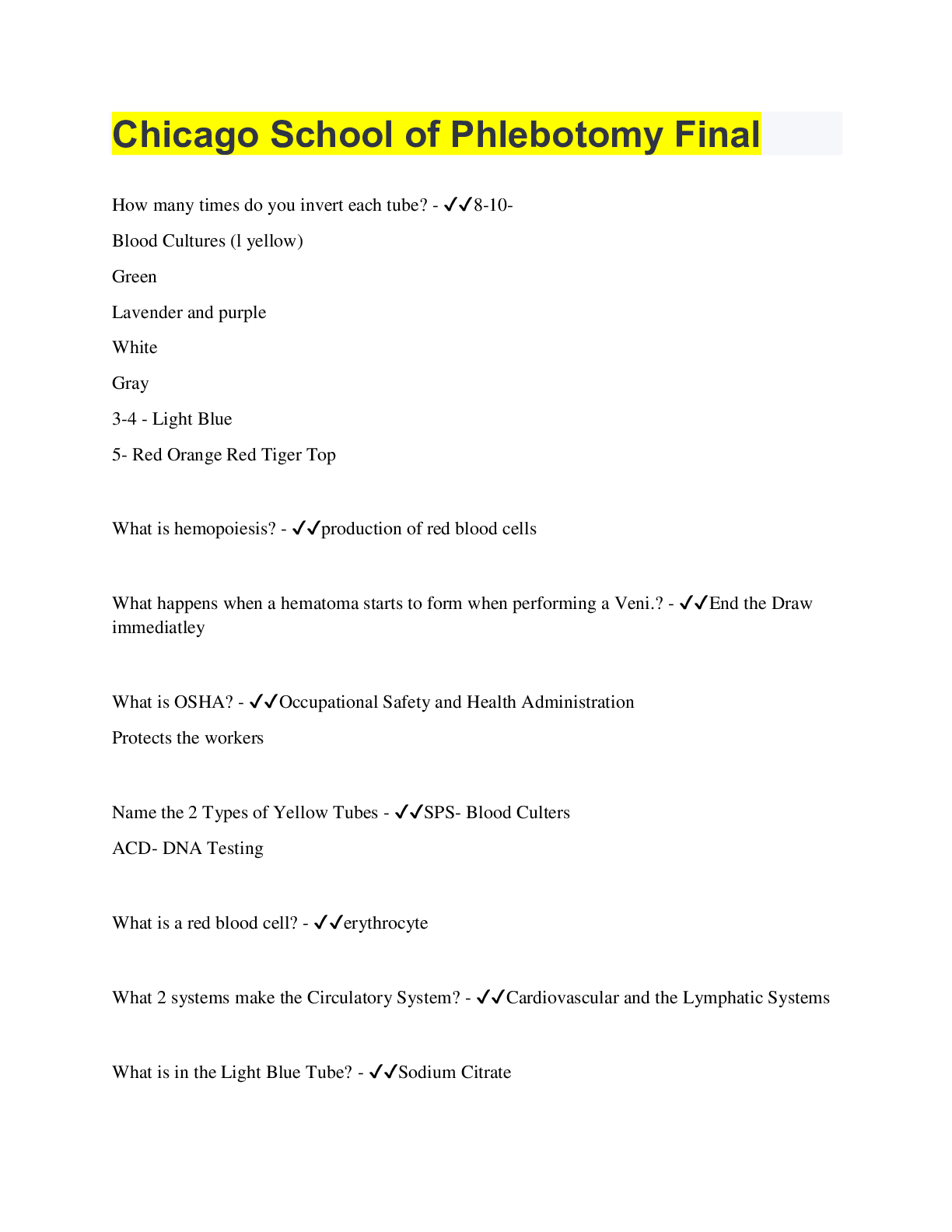
.png)



